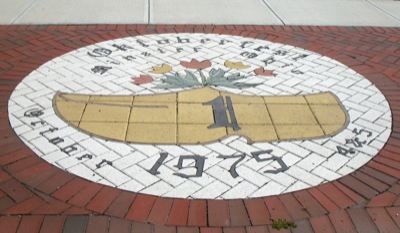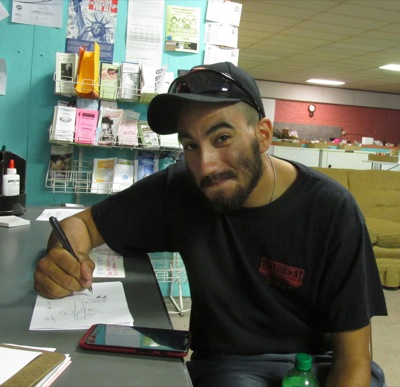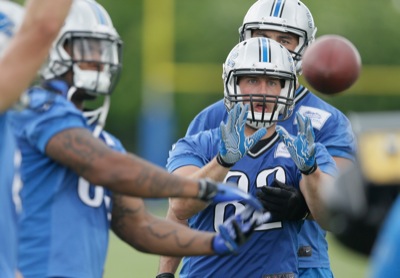Friday, July 18th, 2014
Minster history takes to the streets
By Margie Wuebker

Photo by Margie Wuebker/The Daily Standard
The elaborate logo commemorating the first Oktoberfest in 1975 is part of the Minster Heritage Hunt highlighting the history of the community. Donations financed the project.
MINSTER - Those strolling along the village's Fourth Street can take a history lesson thanks to a new Heritage Hunt feature.
"It's been a long time in the works," village administrator Don Harrod said. "The last art piece (rails representing the interurban of bygone days) went up recently."
An ambitious street reconstruction project launched in 2010 sparked the idea of a picturesque streetscape.
"We wanted to tie memories of things that happened along Fourth Street into today's world," Harrod added.
Officials asked people to share their memories of the community and nearly three dozen responded with information ranging from frog-gigging along the Miami-Erie Canal to watching local baker Tom Kuehner prepare doughnuts and pumpernickel bread.
Kathy Trejo, a landscape designer with Garmann/Miller & Associates, incorporated many of the memories into text. The Kuehner family contributed the famed pumpernickel recipe used week in and week out for decades at the bakery. The plaque with the recipe hangs at the bakery's former location along West Fourth Street.
Harrod admits the Heritage Hunt is a work in progress, explaining some people have suggested possible additions.
"The neat thing about this project is that it can be expanded at any point in the future," he said. "People here are proud of their heritage and it is something they want to share."
The initial piece - a large image of the first Oktoberfest button - was installed in the sidewalk in front of the south park area. Village council members recently received a request to rename the location Oktoberfest Park in honor of this year's 40th anniversary of the celebration.
The button design, worked in laser-cut colored pavers, depicts a large wooden shoe bearing colorful tulips. It bears a large "1" denoting the first festival held Oct. 4 and 5, 1975. The Oktoberfest Committee covered the $12,000 cost.
Three other local organizations - the Civic Association, the Journeyman's Club and the Minster Service Club - raised the remaining $14,137.73 for other pieces.
Some pieces in the overall display are freestanding while others are mounted on building walls or fencing or etched onto brick pavers. Each includes an accompanying sign explaining the significance.
Cast bronze coins decorate pavers near Minster Machine Centennial Park commemorating the village's 1832 origin. Founder Francis Joseph Stallo and six other men acting as agents for a group of 97 German settlers carried $800 in silver coins in a tin box to purchase 640 acres. The Stallostown settlement was divided into 144 lots and the name later was changed to Minster.
Other heritage pieces include a bronze etched movie poster denoting the location of The Crescent Theatre, which opened in 1933 with a short animated Mutt and Jeff film; a pair of wooden shoes commemorating the history of Wooden Shoe Inn; a bronze plaque depicting an Interurban ticket for the trolley that ran from Lima to Sidney; a horseshoe reminiscent of the Busse & Berning Blacksmith Shop (at the present Minster Police Department site); a tailor's shears carved into the pavers where Garmann's Store once stood; and a post office stamp cancellation carved into a stone panel saluting the village's sesquicentennial in 1982.
Embossed tools have been incorporated into pavers at the former location of Hoying and Westerheide Hardware. Benches at Francis J. Stallo Library stand at the former site of Stallo's double log cabin on the northwest corner of Fourth and Main streets.
There is even a whimsical bullfrog perched atop a rock near the canal. Completed in 1845, the waterway gave quick and easy access to the Ohio River and Lake Erie. Donkeys or horses pulled the boats at just 4 to 5 miles per hour. Flooding and faster forms of transportation like the railroads led to the canal's ultimate decline by 1906.
Coordinating plaques explain the historic significance of each piece. The Minster Historical Society is in the process of assembling a brochure that will provide additional information for visitors.
"People will be able to work their way down Fourth Street and see what makes Minster such a great community," Harrod said. "The self-guided tour is more like a treasure hunt where history is concerned."




